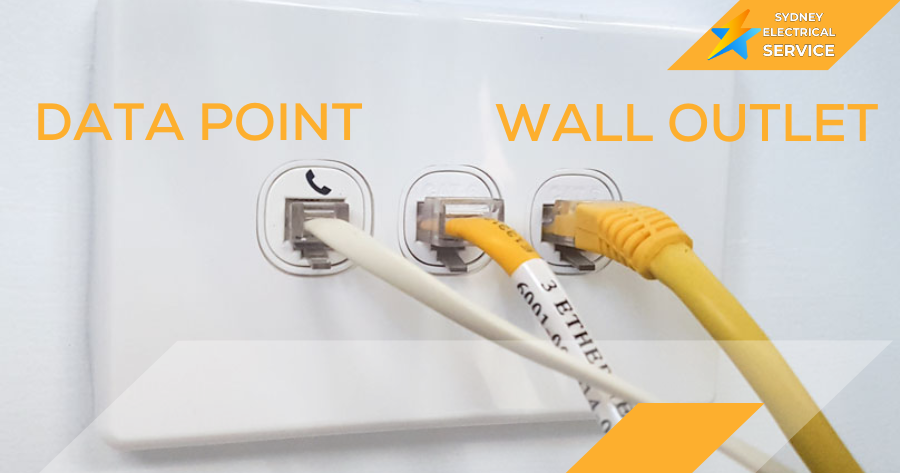Google Reviews ⭐⭐⭐⭐⭐

In today’s connected world, having a robust home data network is essential. This guide delves into the specifics of data outlet and data wall plate installation, ensuring your home is equipped for all your digital needs.
What is a Data Point?
A data point, is a specific point in your home where you can access your data network. It’s essentially an Ethernet port that allows you to connect to the internet or home network. Data points are crucial for high-speed internet access and reliable connectivity for various devices in your home.
The Importance of Data Point Installation
Data point installation is a key aspect of building a functional and efficient home network. Proper installation ensures that you have reliable access points for internet and network connectivity throughout your home. It’s especially important in areas like home offices, entertainment centers, and anywhere you need a stable, wired internet connection.
Enhancing your home’s connectivity starts with proper data point installation.
Here’s a simplified 5-step guide to installing data outlets and wall plates, ensuring a functional and efficient home network.
Step 1: Plan Your Network Layout
- Assessment: Identify the areas in your home where you need data points. Common locations include home offices, living areas, and entertainment zones.
- What is a Data Point?: Understand that a data point (or data outlet) is an access point in your home for wired internet and network connections.
Step 2: Select Suitable Data Outlets and Wall Plates
- Data Outlet Choice: Choose data outlets that match your connectivity needs. Consider the number of ports and the type of internet usage.
- Data Wall Plate Selection: Pick data wall plates that complement your home’s interior design. They should accommodate the number and configuration of your data outlets.
Step 3: Run the Cables
- Wiring: This involves routing Ethernet cables from your central network hub to the locations of your data points. Ensure that cables are properly secured and protected to prevent damage.
Step 4: Install the Data Outlets
- Mounting: Secure the data outlets at the planned locations. This involves connecting the Ethernet cables to the outlets and firmly attaching them to the wall.
- Professional Installation: Consider hiring a professional for data point installation to ensure safety and compliance with Australian Electrical standards.
Step 5: Attach the Data Wall Plates
- Final Touch: Attach the data wall plates once the data outlets are in place. They should fit snugly and provide easy access to the outlets.
- Testing: After installation, test each data point for connectivity and speed to ensure they are functioning correctly.
Post-Installation Tips
Regularly check your data points and wall plates for any signs of damage or loose connections. If you encounter any issues, consult with a emergency electrician for advice or repairs.
Choosing the Right Data Wall Plate
Data wall plates are the finishing touch to your data point installation. They not only encase the data points but also contribute to the aesthetic appeal of your space. When selecting a data wall plate, consider the number of ports needed and the style that best fits your home’s interior design.
Assessing Your Needs:
Determine the number and location of data points based on your daily internet usage and the layout of your home.
Professional Installation:
For optimal functionality and safety, it’s recommended to have your data outlets installed by a professional electrician. They can ensure that the installation adheres to Australian standards and is tailored to your specific needs.

What are Some Uses of Data Points?
Data points, play a crucial role in modern homes by providing dedicated access points for various data and communication needs. Understanding their versatile uses can help you plan your home network system more effectively. Here are some common uses of data points:
- High-Speed Internet Access: The most obvious data point use is wired internet access. They provide a stable and fast connection, which is essential for activities like streaming, gaming, and downloading large files.
- Home Office Setup: For those working from home, data points ensure reliable internet connectivity for video conferencing, large data transfers, and uninterrupted online access, which is critical for productivity.
- Smart Home Devices: As more homes become ‘smart’, data points are essential for connecting smart home devices like thermostats, security cameras, and voice assistants to the internet.
- Entertainment Systems: Data points allow for the seamless streaming of high-definition content on smart TVs and other streaming devices without the lag or buffering that can occur with wireless connections.
- Network Expansion: Data points can be used to expand your home network. By connecting a router or network switch to a data point, you can increase the number of devices that can be connected to your network.
- VOIP Phone Systems: For homes or businesses using VOIP (Voice Over Internet Protocol) phone systems, data points provide the necessary connection to ensure clear and reliable voice communications.
- Gaming: Serious gamers often prefer wired connections for gaming consoles to reduce lag and ensure a stable connection during online gaming sessions.
- Home Surveillance Systems: For a reliable home security system, data points can be used to connect surveillance cameras directly to the network, ensuring continuous and stable video feeds.
By strategically placing data points around your home, you can maximize the functionality of these various devices and systems, ensuring a well-connected and efficient living environment.
Conclusion: Connecting Your Home with Confidence
Installing data outlets and data wall plates is a critical step in ensuring your home is equipped for today’s digital demands. Whether for work, entertainment, or everyday internet use, data points provide the necessary infrastructure for a seamless digital experience.
For expert data point installation services, contact Sydney Electrical Service. Our team specializes in creating efficient and safe home data networks that cater to your specific needs.
At Sydney Electrical Service, we are committed to serving all of Sydney with the highest quality electrical services for data points and wall plates.
Our team of emergency electricians is available around the clock to repair, install, or maintain your wall plates and data points, data cabling, ensuring seamless functionality in your home or business. We proudly extend our service areas the entire Sydney CBD area, Inner West, Eastern Suburbs. Additionally, our expertise includes reliable Level 2 Electrician services, where our skilled professionals handle more complex electrical tasks with precision and care.









